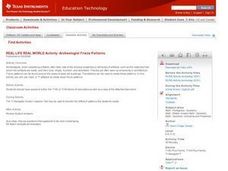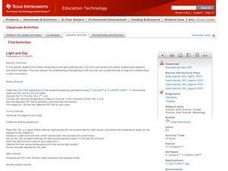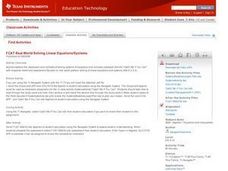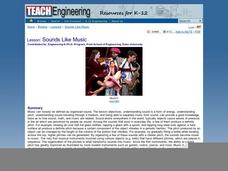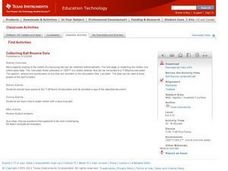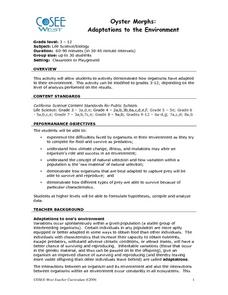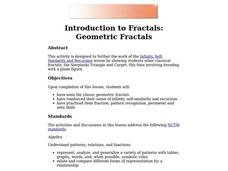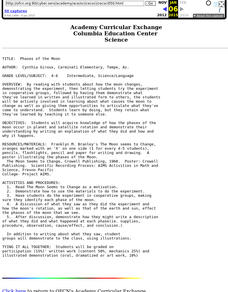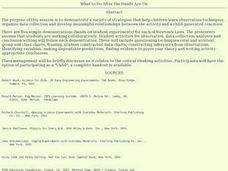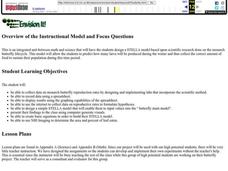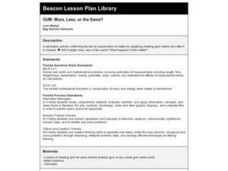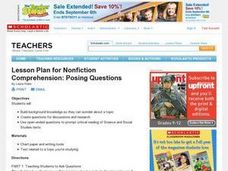Curated OER
Archeologist Frieze Patterns
Learners construct frieze patterns using translations and rotations. They will discuss how frieze patterns are similar to jigsaw puzzles and use Cabri Jr. to build a triangle frieze pattern using rotations, translations, and reflections.
Curated OER
How Do Things Fall?
Students study forces by examining the force of gravitational attraction. They observe how objects fall and measure the force of gravitational attraction upon objects. Students discover that, since gravitational constants are different...
Curated OER
Divisibility Rules Using Scientific Calculators
Young learners apply divisibility rules to determine if a number is a factor of another number. They discuss what numbers are factors of another number and identify patterns using divisibility rules.
Texas Instruments
Light and Day
Pupils explore the concept of collecting data as they collect data on their graphing calculator about time, temperature, and light. Learners plot the data and create histograms and box and whisker plots to analyze the data.
Curated OER
FCAT Real World Solving Linear Equations/Systems
Pupils relate real life situation to the equations, graphs and inequalities. They model real life scenarios using matrices and draw conclusions from their data. This lesson plan is aligned with FCAT.
Curated OER
Fraction Decimal Challenge
Pupils explore the concept of fractions and decimals as they try to find as many fractions as possible that are equivalent to .25. Learners use their calculator to take screen shots and send them to the teacher via Ti-Navigator. They...
Curated OER
The Dewey Decimal System -- Cataloging Collections
Young scholars categorize their private book collections as a precursor to learning the principles of the Dewey Decimal System. They use the Internet to gain a better understanding of the Dewey Decimal System.
Curated OER
What's Matter?
Students explore many of the basic properties of matter including atoms, ions, elements, molecules, and density. The class explores an interactive flash-animated Web site to answer questions and clarify misconceptions they might have had...
Curated OER
Sounds Like Music
Students define and examine the connections between sound and music and how engineers design instruments. They listen to examples of musical instruments, view a demonstration of a tuning fork and bottles filled with varying amounts of...
Curated OER
Collecting Ball Bounce Data
Learners investigate quadratic equations as they use a CBR to collect and analyze data regarding a bouncing ball. Pupils explore different methods for determining the equation of the parabolic path including quadratic regression and...
Curated OER
Oyster Morphs: Adaptations to the Environment
Students demonstrate how organisms adapt to their environment. They examine prey and predators, natural selection, and adaptations by representing oyster morph.
Curated OER
The Six Faces of Garbage
Students use the mathematics of surface area to approach the problem of garbage pollution from the classroom. After watching a video, students construct replicas of cereal boxes and compute their surface area.
Curated OER
Filling the Glass (Water, Air, and Fractions)
Students predict which of two glasses is 1/2 full using visual estimation, height measurement, and liquid measurement methods. Mathematical equations to accurately solve the problem are determined and verified.
Curated OER
Introduction to Fractals: Geometric Fractals
Students study and observe the patterns made by the areas of the Sierpinski Triangle. Students use the computer to draw two or three iterations to discover the number patterns. Students complete worksheets based on Geometric Fractals.
Curated OER
Making Metric And Customary Rulers
Students create a ruler for the purpose of measurement using the standard and metric systems. The rulers are of different lengths and are compared to one another. Then students make conversions of different lengths using both systems of...
Curated OER
Interdisciplinary Approach to Investigating Popcorn
Students conduct a lab experiment using the scientific method. In this interdisciplinary lesson plan, students will test the difference in popping white and yellow corn. Students will write their lab report in their science, math,...
Curated OER
Phases of the Moon
Students research and identify the phases of the moon. They consider the moon's rotation, as well as that of the earth and sun. They write a description of their research and present it to the class.
Curated OER
What To Do After The Hands-Are-On
Learners perform various demonstrations for each of Newton's Laws, collect data, and write a conclusion for each.
Curated OER
Overview of the Instructional Model and Focus Questions
Students design STELLA model based upon scientific research done on monarch butterfly lifecycle; model allows students to predict how many larva will be produced during the winter and thus collect the correct amount of food to sustain...
Curated OER
Storytelling: Using the arts to enrich the curriculum
Students examine storytelling in a cross curricular unit. Language arts, social studies, science and math are all incorporated in this project as well as technology through the use of Hyperstudio.
Curated OER
GUM: More, Less, or the Same?
Students confirm the law of conservation of matter by weighing chewing gum before and after it is chewed.
Curated OER
Children's Books
Students use their personal experiences to create students's books for younger students on topics to which they can relate. Students observe a guest speaker who talks about different formats of students's books that are available, then...
Curated OER
Lesson Plan for Nonfiction Comprehension: Posing Questions
Students practice writing questions on a selected topic. Students discuss questioning skills. They browse through books and magazines, review their textbooks, watch a film, or participate in a similar experience that will provide some...
Curated OER
Ancient Greece Across the Curriculum
Sixth graders explore Ancient Greece using resources in literature, math, social studies, and science.
